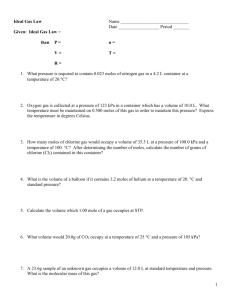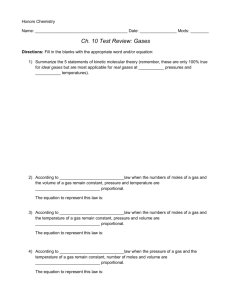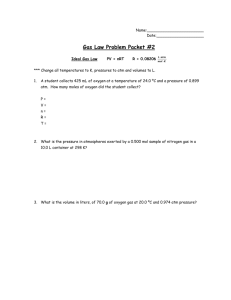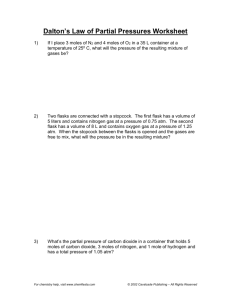WORKSHEET #1 PARTIAL PRESSURE
advertisement
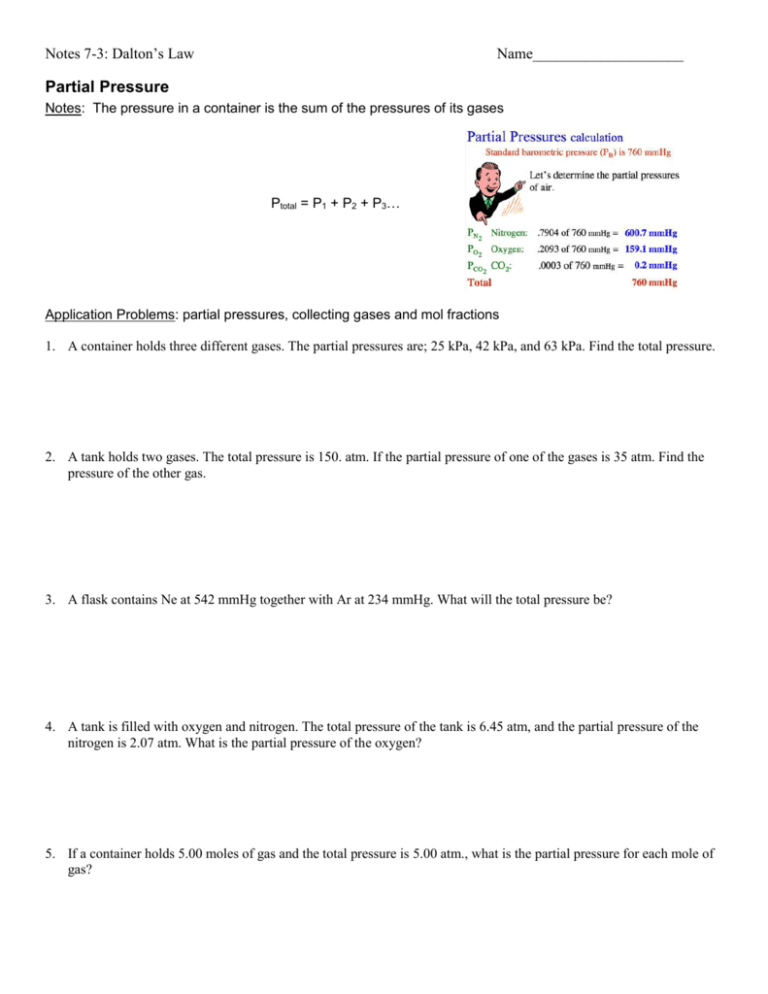
Notes 7-3: Dalton’s Law Name____________________ Partial Pressure Notes: The pressure in a container is the sum of the pressures of its gases Ptotal = P1 + P2 + P3… Application Problems: partial pressures, collecting gases and mol fractions 1. A container holds three different gases. The partial pressures are; 25 kPa, 42 kPa, and 63 kPa. Find the total pressure. 2. A tank holds two gases. The total pressure is 150. atm. If the partial pressure of one of the gases is 35 atm. Find the pressure of the other gas. 3. A flask contains Ne at 542 mmHg together with Ar at 234 mmHg. What will the total pressure be? 4. A tank is filled with oxygen and nitrogen. The total pressure of the tank is 6.45 atm, and the partial pressure of the nitrogen is 2.07 atm. What is the partial pressure of the oxygen? 5. If a container holds 5.00 moles of gas and the total pressure is 5.00 atm., what is the partial pressure for each mole of gas? Collecting Gases over Water The pressure in a container is the sum of the pressures of its gases. Whenever a problem involves gas collected over water we need to subtract the contribution that water vapor contributes pressure 6. A sample of nitrogen gas is collected over water at 20ºC and a pressure of 1.00 atm. The volume of the collected gas is 250.0 L. What is the partial pressure of the nitrogen gas? (At 20ºC, the vapor pressure of water is 17.5 torr) Dalton’s Law: Ptotal = Pnitrogen + Pwater Solving this problem: Pnitrogen = Ptotal - Pwater 7. A sample of hydrogen gas is collected over water at 22ºC. The pressure of the resultant mixture is 765torr. What is the pressure that is exerted by the dry hydrogen alone? Partial Pressure and Mole Fractions Because a mole of any gas at a given temperature has the same number of molecules as any other gas at that temperature, the pressure in a container is the sum of the number of moles of each of its gases 8. If a container holds 2.00 moles of hydrogen gas and 2.00 moles of helium gas, and the total pressure is 4.00 atm., what is the partial pressure of each of the gases? 9. If a container holds 1.00 mole of oxygen gas and 3.00 mole of argon gas and the total pressure is 800 Torr, what is the partial pressure of each of the gases? 10. If a container holds 1.50 moles of nitrogen gas and 2.50 moles of helium gas at a total pressure of 760 mm Hg, what is the partial pressure of each of the gases? 11. A 22.4 liter container has a total pressure of 760 Torr at 0.0˚C and contains three different gases, nitrogen, helium and argon. If the partial pressure of nitrogen is 250 Torr and the partial pressure of argon is 130 Torr, what is the number of moles of helium in the tank? Grams to Moles and Mole Fraction If we know the mass of the gases we can convert their mass to moles, then determine the mole fraction and partial pressure of gases 12. A container with a volume of 5.60 l holds 71.0g chlorine gas and 4.00g helium gas. If the total pressure is 760 mm Hg what is the partial pressure of both gases?


